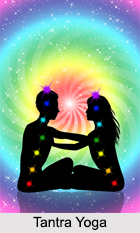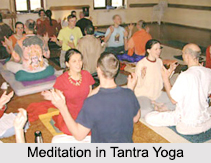 Tantra Yoga holds a special place for the Hindus as it is a potent power for spiritual regeneration. It enlightens the one who is in darkness. It is a unique approach which studies the phenomenon of the entire universe from the perspective of the individual. A lot of sciences including astronomy, astrology, numerology, physiognomy, physics, chemistry, Ayurveda, psychology, mathematics and geometry are included within the realm of Tantra Yoga. Tantra Yoga does not limit itself to a particular branch of study rather it incorporates in it diverse elements which are linked together with a unifying rule of the Dharma. Rather the essence of Tantra Yoga is to understand the Dharma in the absolute sense.
Tantra Yoga holds a special place for the Hindus as it is a potent power for spiritual regeneration. It enlightens the one who is in darkness. It is a unique approach which studies the phenomenon of the entire universe from the perspective of the individual. A lot of sciences including astronomy, astrology, numerology, physiognomy, physics, chemistry, Ayurveda, psychology, mathematics and geometry are included within the realm of Tantra Yoga. Tantra Yoga does not limit itself to a particular branch of study rather it incorporates in it diverse elements which are linked together with a unifying rule of the Dharma. Rather the essence of Tantra Yoga is to understand the Dharma in the absolute sense.
Aims of Tantra Yoga
Tantra Yoga aims to bring in consciousness in all the three states of human life; that is, in the conscious state, the waking state and in the dream state. In order to attain this consciousness, the human mind needs to seek immense spiritualism and deep knowledge. Tantra Yoga teaches the methodology and the ways which discards intolerance, ignorance, selfishness and the animal instinct that is present in human beings. Tantra Yoga thus concentrates on a single point that helps individuals to emancipate the consciousness from limitation.
Role of Shakti in Tantra Yoga
 Universe is made of two opposing forces, while Lord Shiva being the static principal, Shakti is the dynamic force. Shakti stands for creativity, energy and power. The external part of everything is the creative aspect and inside every dynamic aspect lies the static part. The role of Shakti has neither any beginning nor any end. Although energy is restless yet it moves in an orderly cycle following alternate periods of rest and motion. The phenomenon of energy undergoes a lot of changes. It gets distorted and gets reorganized during its period of rest. Thus it can be said that there is a constant process of creation, preservation, destruction, reorganization and recreation in this world. According to the Tantra Yoga, Shakti is the Universal Mother who has the power to create, destroy and sustain. As a result the essence of Tantra Yoga lies in worshipping Shakti as an aspect of the Divine.
Universe is made of two opposing forces, while Lord Shiva being the static principal, Shakti is the dynamic force. Shakti stands for creativity, energy and power. The external part of everything is the creative aspect and inside every dynamic aspect lies the static part. The role of Shakti has neither any beginning nor any end. Although energy is restless yet it moves in an orderly cycle following alternate periods of rest and motion. The phenomenon of energy undergoes a lot of changes. It gets distorted and gets reorganized during its period of rest. Thus it can be said that there is a constant process of creation, preservation, destruction, reorganization and recreation in this world. According to the Tantra Yoga, Shakti is the Universal Mother who has the power to create, destroy and sustain. As a result the essence of Tantra Yoga lies in worshipping Shakti as an aspect of the Divine.
The world is illusory where the driving force is the power of desire (Ichcha Shakti). The desire is present in one who is without attributes or in the Brahmana. Tantra Yoga believes the primary driving force behind the universe is nothing but desire. Without desire it is not possible to go on with the continuity of this world. As a result Tantra Yoga does not encourage human beings to renounce their desires. The state of desirelessness can only be achieved with the help of asceticism according to Tantra Yoga and the paradox of Tantra Yoga is that an individual should have a strong desire to culminate to a state of desirelessness.
Meditation in Tantra Yoga
Tantra Yoga imparts the idea that desires are very natural for a soul embodied within a human body. Sense organs of human beings serve as windows through which desires seep into human body. Moreover presence of desire within an individual encourages the desire for a particular object. Most individuals come within the clutches of physical desires which include bodily comforts. As a result individuals get dominated by their physical instincts. Such desires constitute the lower part of human personality and as a result humans fall prey to negative feelings like disturbance, isolation, unease, disappointment, egotism and depression. Tantra Yoga brings physical and mental cleansing through Pranayama or breathing exercises, visualization of Yantra and deities, repetition of Mantra or Japa, etc. Thus Tantra Yoga helps to discover the divine nature of individuals through various processes.




















